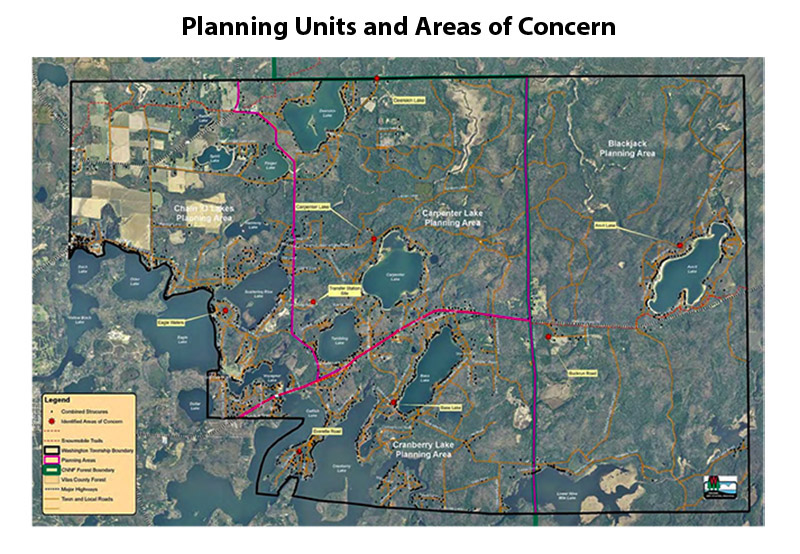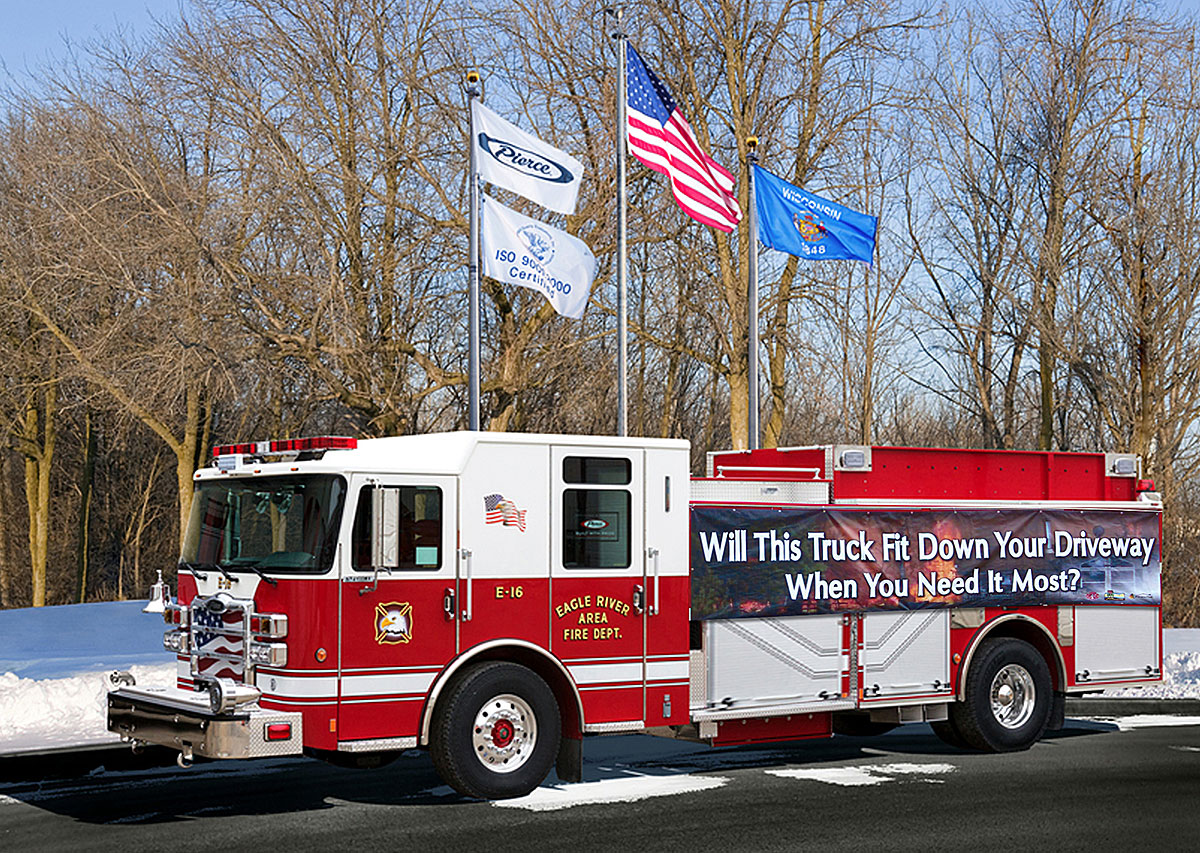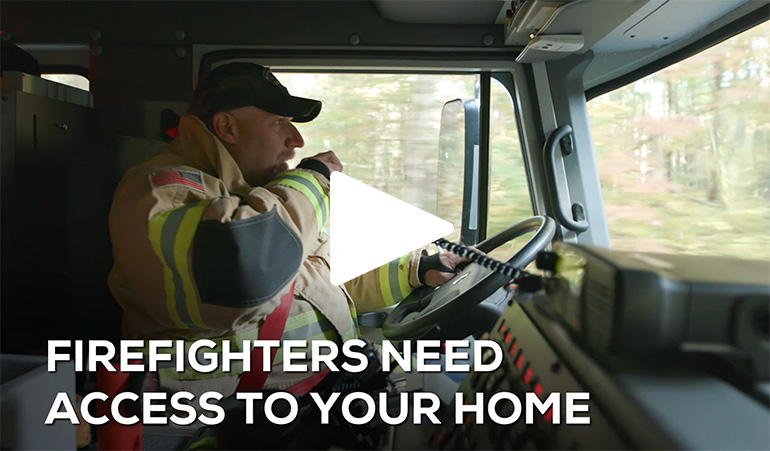Community Wildfire Protection Education
Posted 03/15/2024
WHAT DO THE FIRE DANGER RATINGS MEAN?
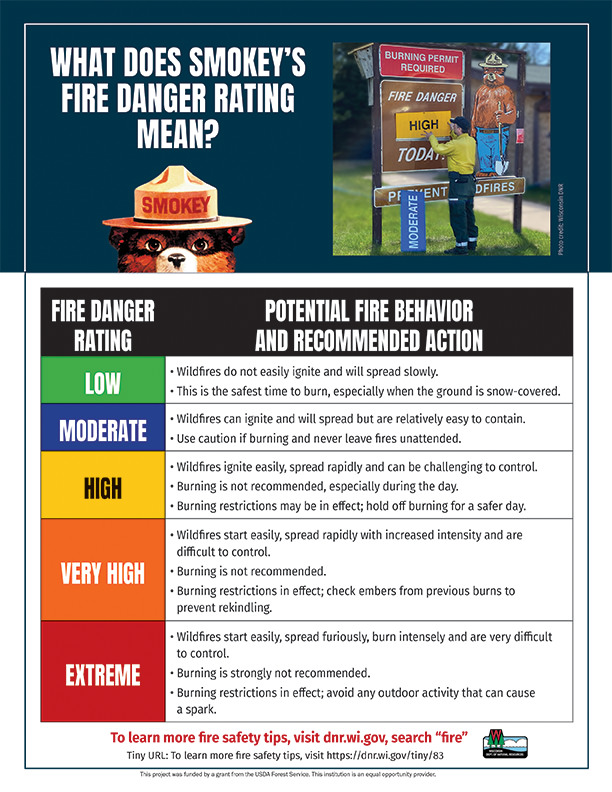
Posted 12/28/2023
WINTER FIRE SAFETY TIPS
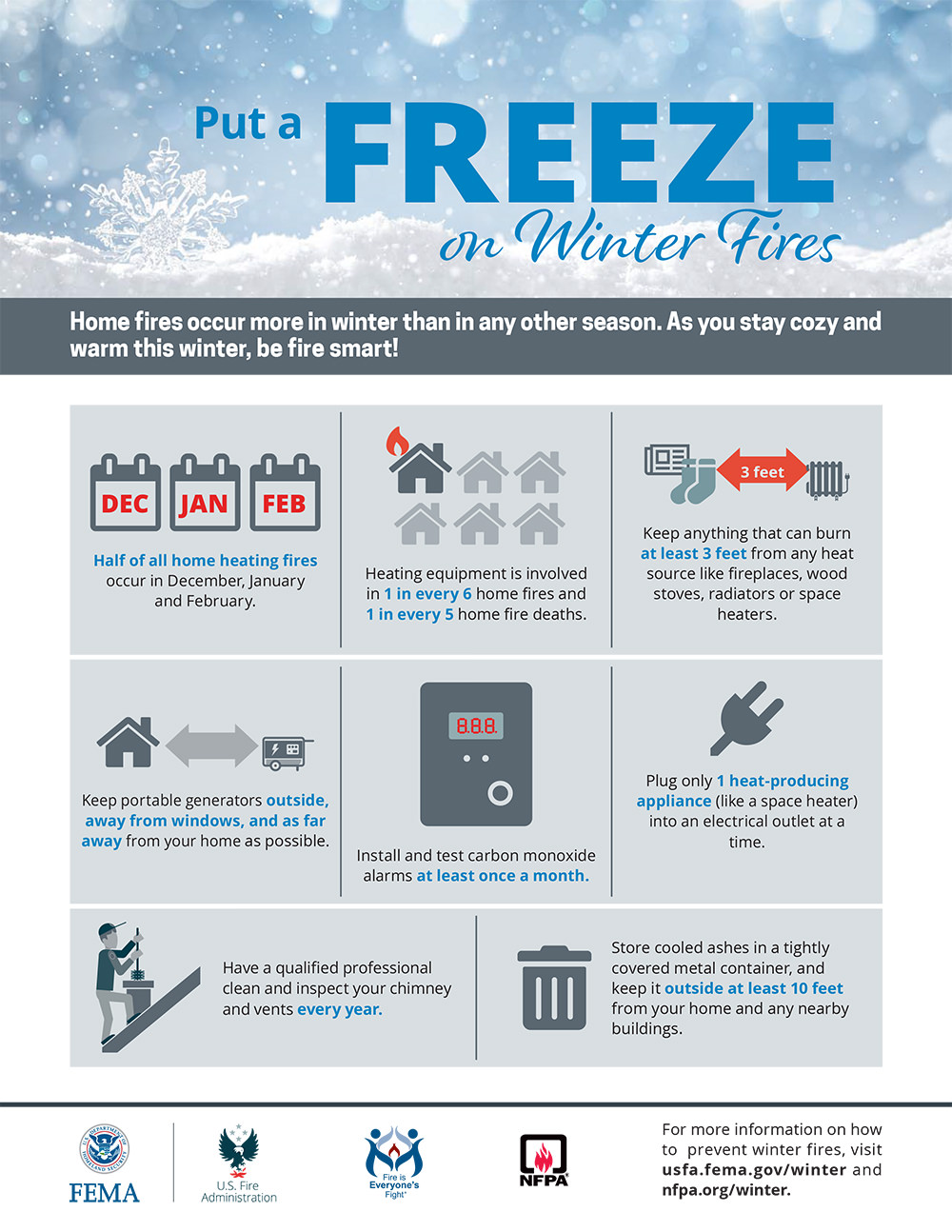
Posted 4/17/2023
NEW GRANT FOR THE TOWN OF WASHINGTON
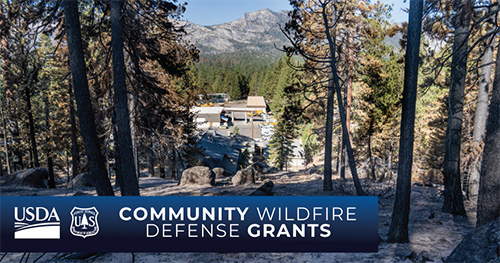
We are pleased to announce the Town of Washington has been awarded a Community Wildfire Defense Grant in the amount of $246,938.45.
Funded by President Biden’s Bipartisan Infrastructure Law, the Community Wildfire Defense Grant (CWDG) program helps communities plan for and mitigate wildfire risks.
The USFS administers this grant, and it invested $197 million in the initial round of funding.
The grant proposal was written by Carole Linn, a member of the town CWPP team.
100 grant proposals were selected representing 22 states and seven tribes. CWDG grants will make $1 billion available over five years to assist at-risk communities.
There were more than 400 applications nationwide requesting more than $525 million during this application cycle. Only three projects were funded in the northeast-midwest section of the United States. The Town of Washington was one of those three projects!
The purpose of our Fuels Reduction Project is to augment, enhance, and expand the Town of Washington Community Wildfire Protection Plan (CWPP) to protect lives, property, and resources from wildfire and provide for public safety. This will be accomplished through the following projects:
Improve wildfire planning efforts and increase the public's and emergency responders' safety through vegetation management on town rights-of-way. This will be accomplished on all 72 miles of town roads rights-of-way through mowing and cutting using a leased John Deere tractor, boom mower, and swing flail for a total cost of $212,938.45. The Town will own the tractor at the end of the lease period.
Reduce hazardous fuels to mitigate fire danger by supporting the Town's brush site through annual chipping. Foley Tree Service will chip the brush site and remove the chips at a cost of $6,800 per year for 5 years for a total cost of $34,000.
- Saves money by reducing the need for expensive bags and commercial soil additives.
- Helps gardens and lawns by improving the fertility and health of the soil.
- Saves water by helping the soil hold moisture and reducing water runoff.
- Improves the environment by recycling valuable organic resources and extending the lives of landfills.
- Do compost grass clippings, leaves, weeds, garden debris, small brush, twigs, clean wood ash, sawdust, wood chips, eggshells, coffee grounds and food waste.
- Don’t compost whole branches or logs, pet waste, charcoal briquette ash, sawdust from treated wood, meat or dairy food items.
- Ensure your driveway has a MINIMUM of 12 feet width clearance and 13.5 feet height clearance
- Ensure your fire number is clearly visible from the road
- Ensure your driveway has a firmly packed surface able to support the weight of a fire truck
- Ensure your driveway is free of gates, fences, or other obstructions
- Ensure adequate room for the fire truck to turn around once it reaches your home
- solely for warming or cooking purposes
- smaller in size and comprised of clean and dry wood
- contained within a designated fire ring or surrounded by rocks
- allowed anytime, except when Emergency Burning Restrictions are in effect
- is burning in a fire ring with the intent to eliminate debris
- requires a burning permit
- Cut back the flowering plants that have faded and compost the debris.
- Remove any dead trees, branches or shrubs.
- If you have evergreens around your home, look at how close they are to one another. Evergreens are especially flammable.
- Consider removing any trees necessary to keep at least 15 feet between the branches from tree to tree within 30 feet of buildings.
- Prune lower branches up and away from the ground.
- Bring your yard debris to our brush collection site located across from the entrance to the transfer station. It's open 24/7 until mid-November
We are grateful for our partnership with the WDNR. Through their support of our CWPP, we were able to take advantage of this funding opportunity. Special thanks to Laura Hayes, WDNR Wildland Urban Interface Specialist, for her hard work and dedication to facilitating the Town of Washington CWPP.
Posted 3/1/2023
COOL NEW APP
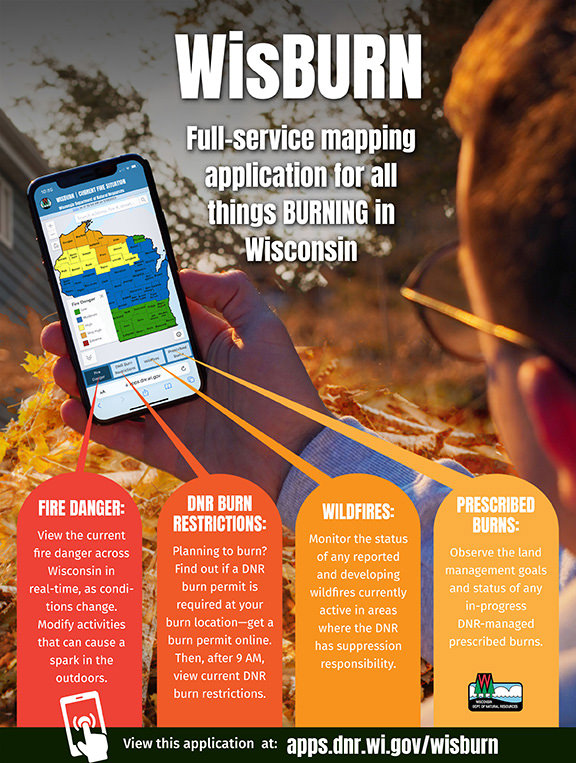
Use it to access all burning permit information, fire danger, and burning restrictions.
It also can be used to monitor wildfires and see where there are prescribed burns.
Mobile friendly
Check it out HERE
Posted 6/4/2022
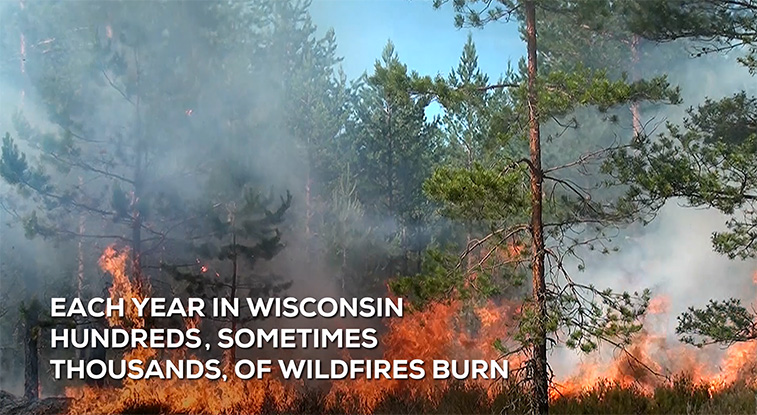
YOU'RE THE FIRST LINE OF DEFENSE!
As the homeowner, you are the first line of defense when it comes to helping your home survive a wildfire.
Do your part to ensure adequate driveway access!
Is your driveway at least 12' wide with at least 14' of overhead clearance?
Is there room for an emergency vehicle to turn around?
Do you have a safe route to leave your property if necessary?
Download the WDNR driveway access pamphlet here
View this great driveway access video for more information.
Posted 1/28/2022
WISCONSIN WILDFIRE STATS FROM 2021
Wisconsin wildfire count 1,086
Acres burned 2,582.42
Total cost $869,907.56
According to Ryan Brown, WDNR Forestry Technician, the Eagle River WDNR fire response area saw a tick above the past few years for fire activity and acreage burned.
13 fires for 3.82 acres. #1 cause of fires was still debris burning.
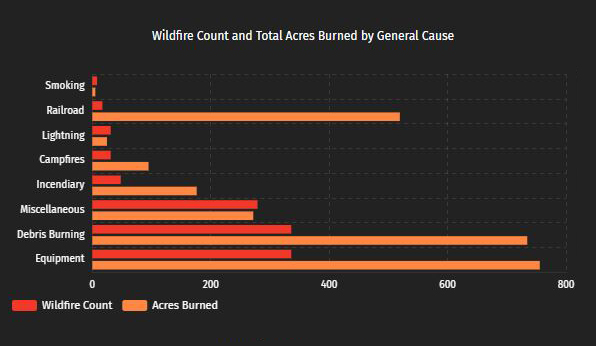
336 debris caused fires burned 734.57 acres
336 equipment caused fires burned 755.7 acres
Posted 1/13/2022
PRUNE OAKS IN WINTER TO AVOID OAK WILT
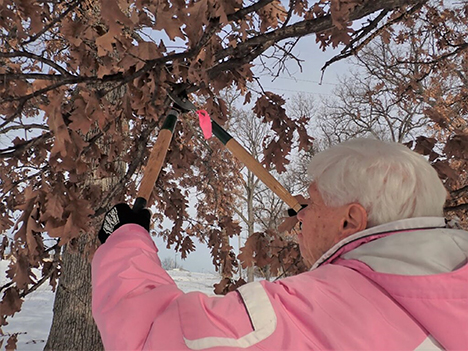
Oak wilt is Wisconsin’s most destructive oak disease, killing thousands of healthy trees annually.
Start the year off by pruning your trees to protect them from harmful pests that emerge after the thaw.
It is ideal to prune trees in the winter since branch damage or weak branch structure is more visible and because pests that cause harmful tree diseases are inactive in cold temperatures. One such disease is oak wilt, a fatal disease that spreads through tiny sap-feeding beetles attracted to open wounds on trees.
“What’s encouraging about oak wilt is that preventing and slowing its spread takes only the most basic measures,” said Paul Cigan, DNR Forest Health Specialist.
The WDNR encourages Wisconsin residents to only prune trees in winter. Pruning oaks during April through July places them at the greatest risk for oak wilt infection and should be avoided when possible.
It also suggests keeping firewood transport local and reporting oaks with sudden, mid-to-late summer leaf drop immediately to a certified professional.
Prune young trees to establish a central trunk, proper trunk taper and good branch structure and spacing. Prune older trees to remove dead or hazardous limbs. In addition, it’s recommended to prune landscape trees throughout their lifetime to maintain strong structure and remove dead wood.
Posted 10/8/2021
TIRED OF BAGGING LEAVES? TRY COMPOSTING INSTEAD!
Raking up fallen leaves can be a fun fall activity, but have you thought of composting instead? Composting is nature’s way of turning your leaves and grass into a valuable soil conditioner.
Composting has several benefits. It:
Getting started is easy. All you need is a pitchfork, rake and shovel, a compost bin and some soil. Compost bins can be purchased at a hardware store or made of inexpensive blocks, wire, wood or snow fencing.
There are a few do’s and don’ts for proper composting.
If you can't or don't want to compost at home, bring your grass clippings, leaves,weeds, and twigs to the town brush site compost area. Deposit the materials in the area indicated, and our road crew will add the materials to the compost bins and mix with limestone. Composting takes several years. A sign is posted when the compost is ready. You are welcome to take the compost!
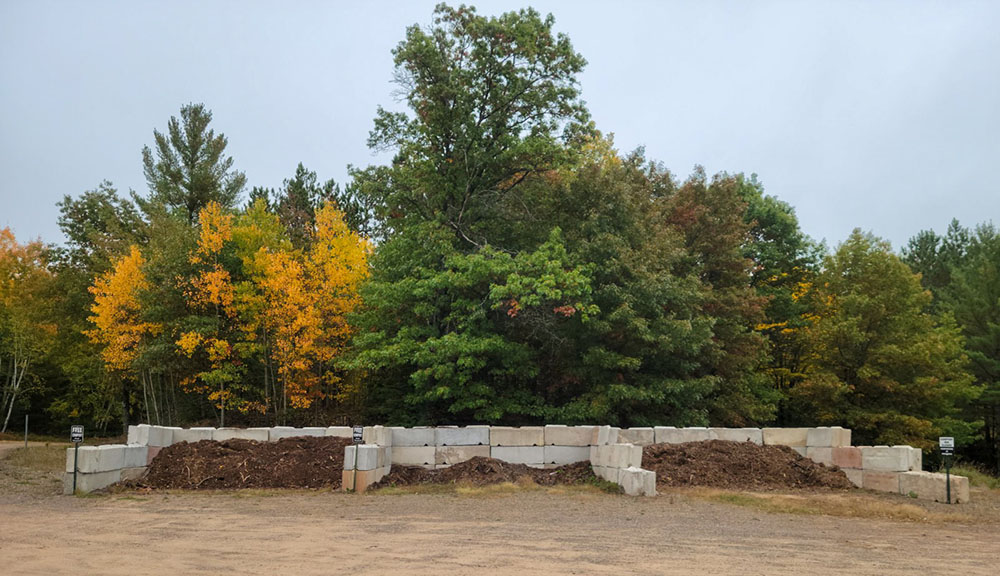
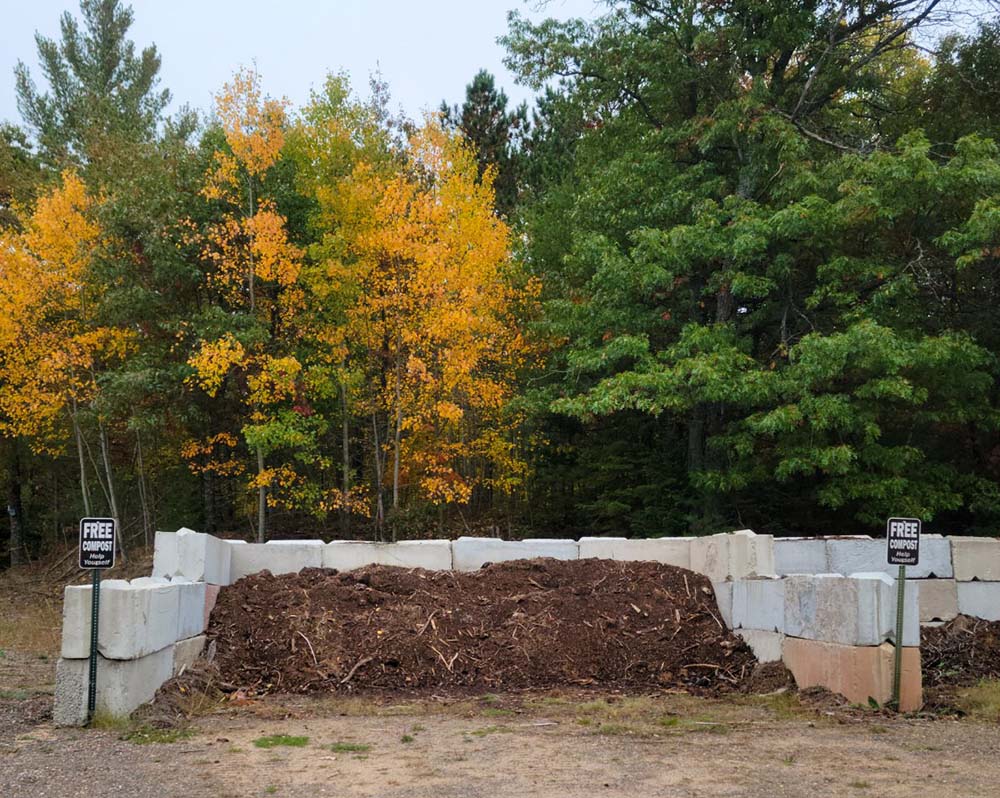
Posted 2/26/2021
CHANGES IN OBTAINING BURN PERMITS THIS YEAR
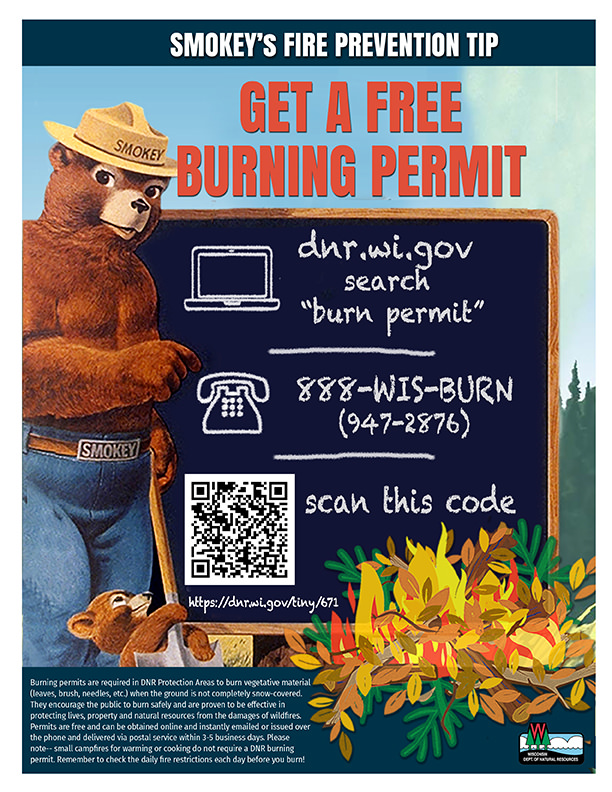
As of January 1,2021, the Department of Natural Resources will NOT be issuing burning permits in-person from Emergency Fire Wardens or by DNR personnel at state offices until further notice.
Permits are free and can be obtained online and instantly emailed or issued over the phone and delivered via postal service within 3-5 business days. The public is encouraged to plan ahead.
Speaking of planning ahead, the safest time to burn is when the ground is completely snow covered.
Posted 2/4/2021
WINTER FIRE SAFETY
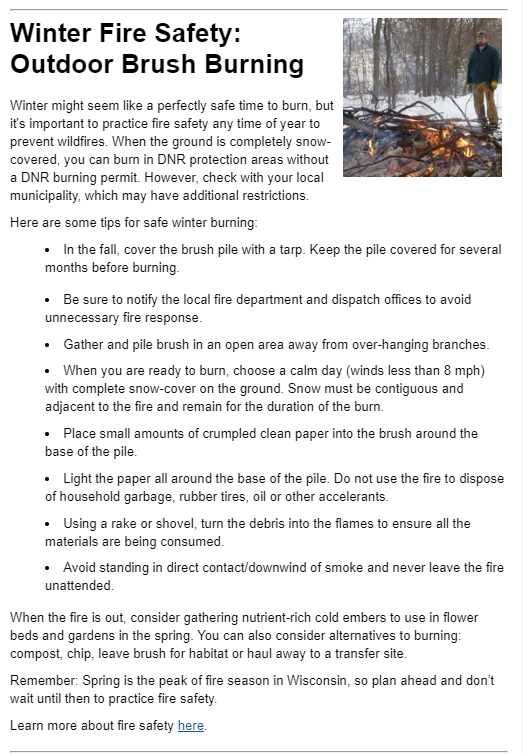
Posted 9/27/2020
FALL CLEANUP JUST AROUND THE CORNER
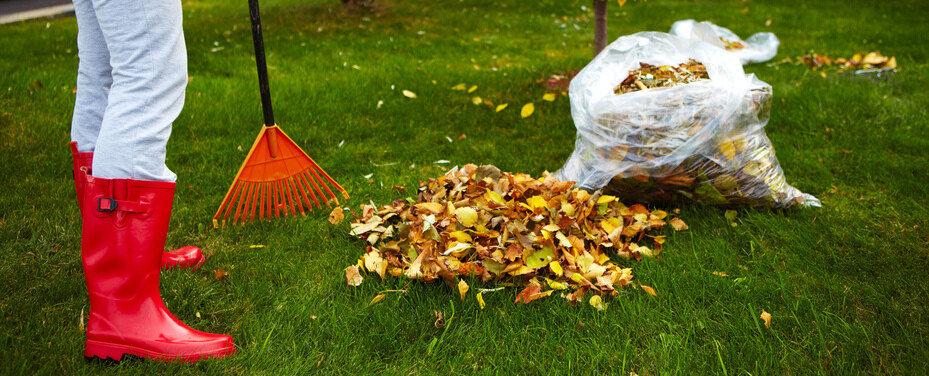
While we see most Wisconsin wildfire activity in the spring, fires can occur any time of the year when snow is not on the ground. We see spikes in occurrence in summer during dry spells and again in autumn when the leaves fall.
All this dry matter can become fuel for a wildfire. Removing this debris is particularly important if you live or own property in a community at risk for wildfire - which the Town of Washington is. In short, these are areas where sandy soils, oaks and pine trees are abundant.
What can you do? Start with the area immediately around your home and work outwards from there.
• Cut back the flowering plants that have faded and compost the debris.
• Remove any dead trees, branches or shrubs.
• If you have evergreens around your home, look at how close they are to one another. Evergreens are especially flammable.
• Consider removing any trees necessary to keep at least 15 feet between the branches from tree to tree and within 30 feet of buildings.
• Prune lower branches up and away from the ground.
• Bring your yard debris to our brush collection site located across from the entrance to the transfer station. It's open every Friday 4PM until Monday 6AM until November 1st.
Posted 3/29/2020
PRESCRIBED BURNS
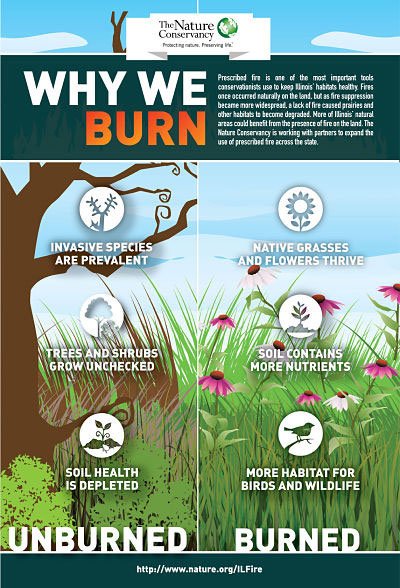
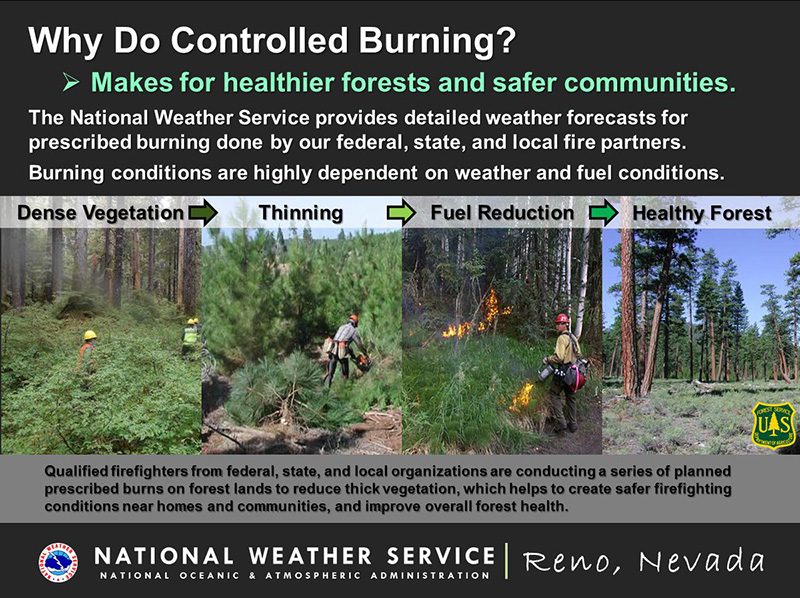
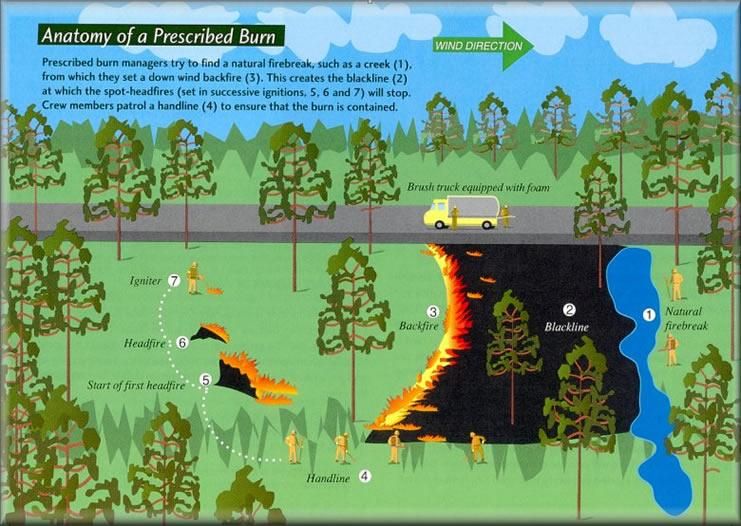
Posted 3/7/2020
WISCONSIN WILDFIRE STATISTICS FROM 2019
In 2019 there were 710 wildfires in Wisconsin DNR Protection Areas. 1,242 total acres were burned by these fires. 232 primary structures were saved and 16 primary structures were lost. 108 secondary structures were saved and 11 secoondary structures were lost.
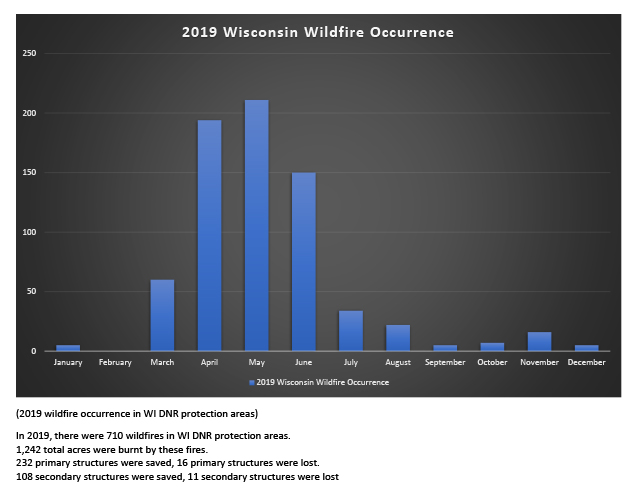
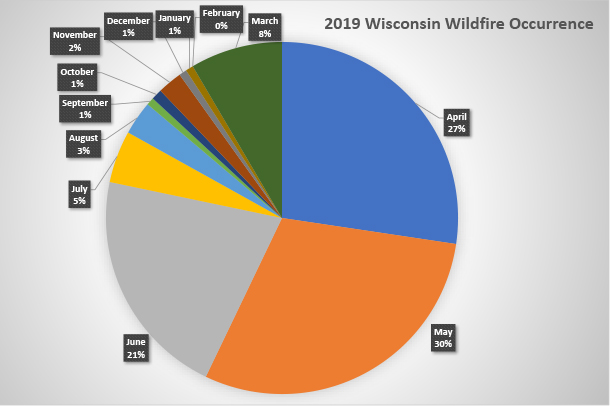
The number one cause of wildfires in WI DNR protection areas during 2019 was debris burning. The chart shows some of the other causes of Wisconsin wildfires in 2019.
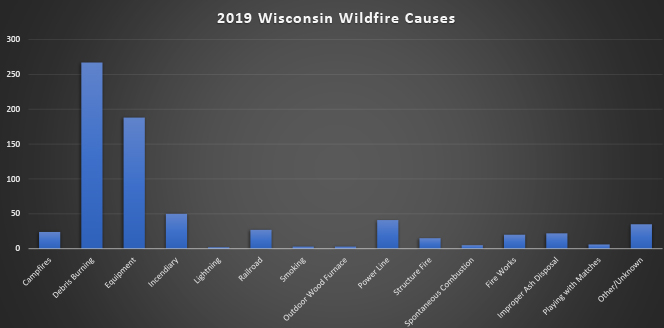
These charts show the causes and occurrence of wildfire in Vilas County in 2019.
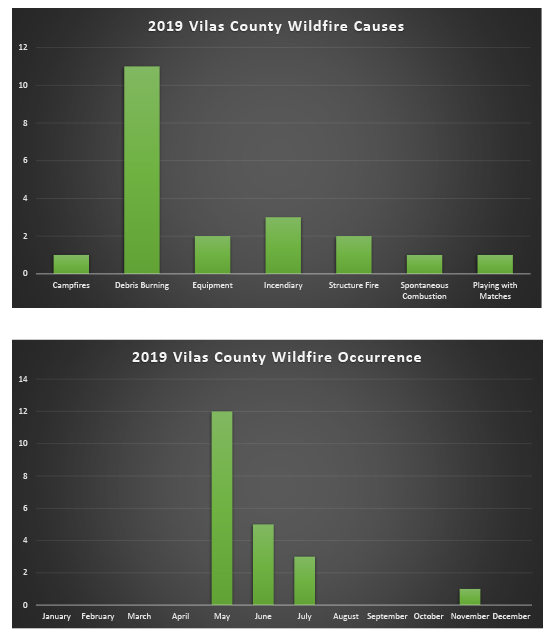
Posted 9/21/2019
COULD A FIRE TRUCK FIT DOWN YOUR DRIVEWAY?
We live in an area of high wildfire risk!
Is your home in the forest? Is your lakeshore home surrounded by oak and pine trees? Is the soil around your property sandy? Are there tall grasses around your home? If you answered yes to any of these questions it is likely your property is at increased risk for wildfire. If a wildfire occurred, could a fire truck fit down your driveway? If a fire truck can't safely drive down your driveway, your home may be at increased risk of damage.
There are things you can do to lessen the risk:
Long, winding, narrow driveways may not be accessible by large fire trucks!
Posted 8/8/2019
HAPPY 75th BIRTHDAY TO SMOKEY BEAR
“As far as recognition goes, Smokey Bear ranks right up there behind Santa Claus and Mickey Mouse,” says Catherine Koele, Department of Natural Resource wildfire prevention specialist. “Many of us remember Smokey from our childhoods. We’d see him in parades, on posters, in magazines or occasionally in TV commercials. If we were lucky enough, maybe he’d stop by the classroom and teach us about fire safety.”
Take a peek at the History of Smokey Bear—a timeline of important events over the last 75 years!
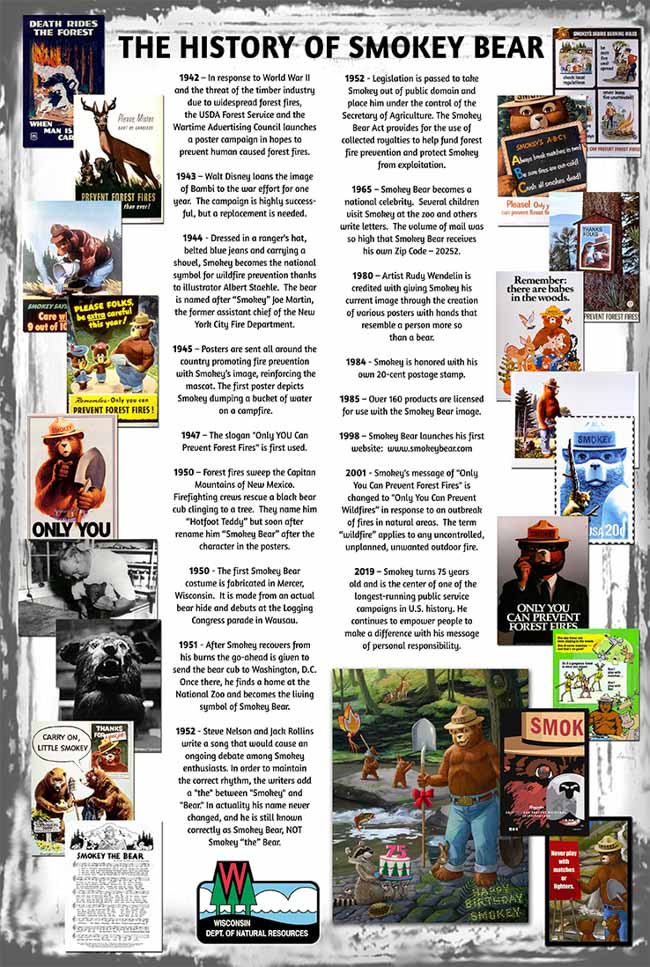
Posted 7/23/2019
PROTECT YOUR LAKEFRONT HOME FROM WILDLAND FIRE
Here are some tips to protect your shoreland home from wildfire.
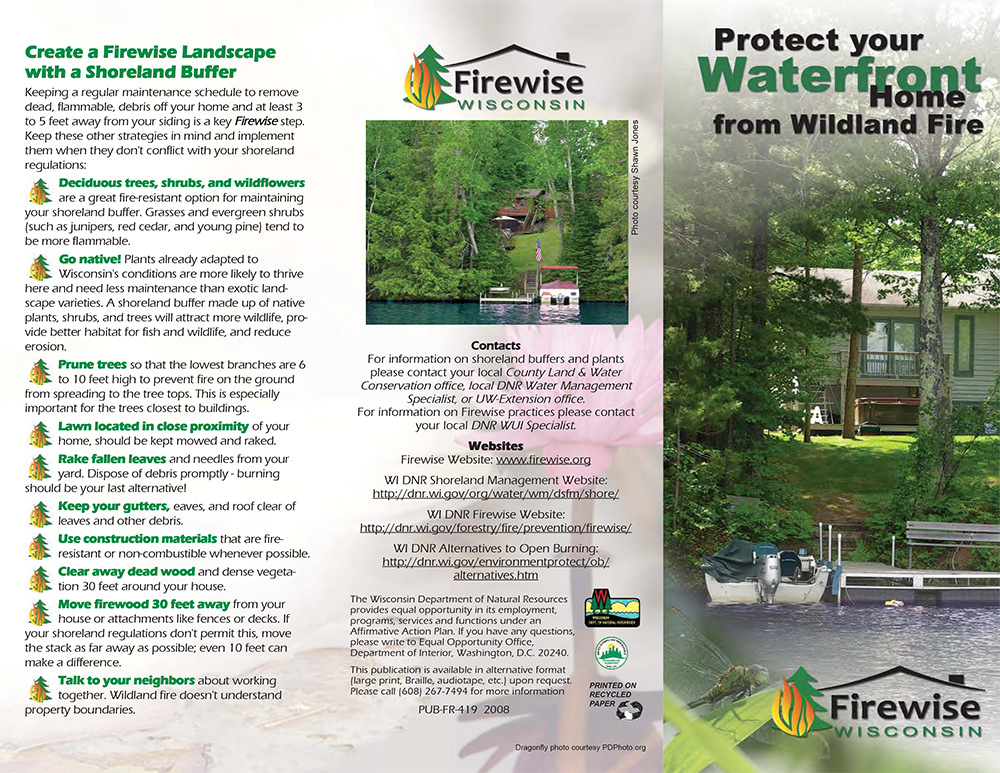
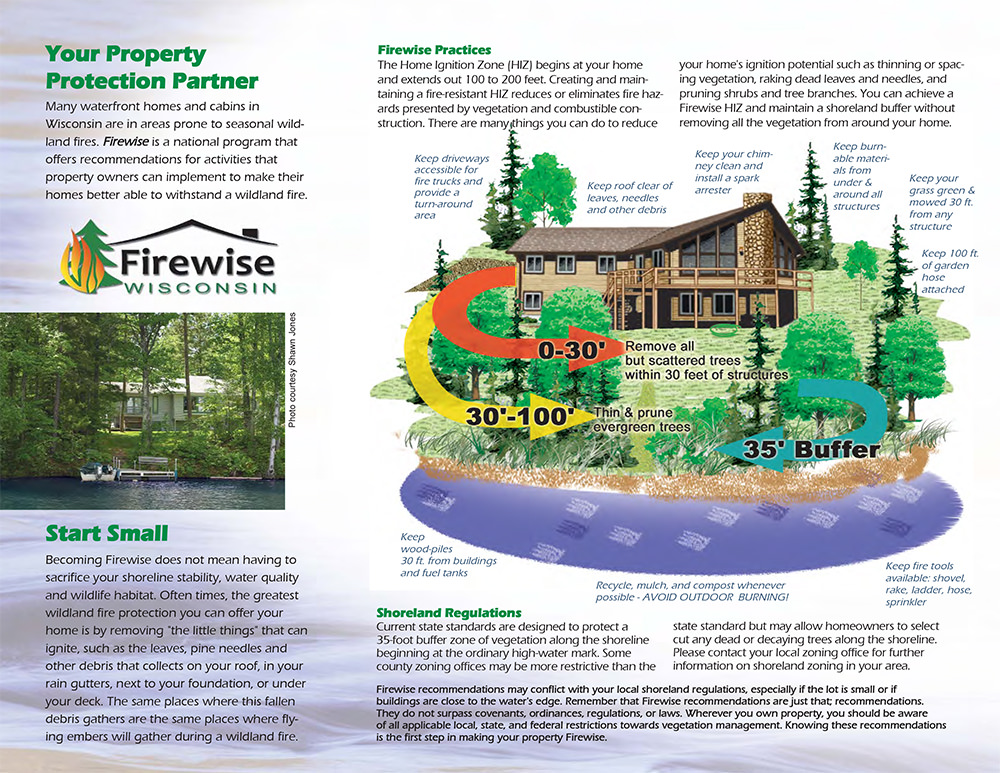
Posted 5/19/2019
CAMPFIRE VS DEBRIS FIRE
Do I need a burning permit?
There's a difference between a campfire and a fire to dispose of debris. A campfire does not require a burning permit, a fire to dispose of debris REQUIRES a burning permit. They can look similar. Campfires are:
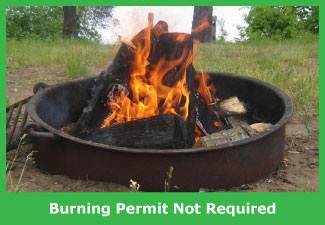
Debris burning:
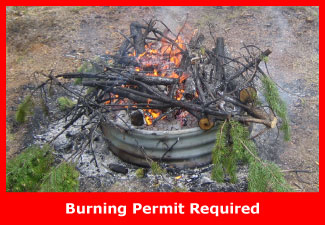
The majority of campfire-caused wildfires in Wisconsin are the result of leaving the fire before it was properly extinguished. Never cover your campfire with dirt and walk away from it. This creates a "Dutch oven" and coals may remain hot for days or weeks until conditions are ripe for the fire to escape.
Remember to check the daily burning restrictions and never leave a fire unattended.
Posted 4/26/2019
SAFEGUARD YOUR HOUSE FROM WILDFIRE
With wildfire season upon us in northern Wisconsin, here are some great tips on how to protect your house from wildfires
With the nicer weather, homeowners are cleaning up around their properties, sometimes choosing to burn leaves and branch debris.
Debris burning is the leading cause of wildfires, especially this time of year. Burning is not your only option. Try alternatives such as bringing your debris to the town brush collection site, composting, or leaving brush in the woods for wildlife cover. The best practice is to not burn at all or to wait until surrounding vegetation greens-up in the summer.
If you do burn, get a burning permit (it's required) and follow the rules of the day. You can stay aware of fire danger and burning permit requirements by checking the WDNR website or by calling 1-888-WIS-BURN. Information is updated each day at 11 a.m.
Get a burning permit here
Posted 4/04/2019
KNOW YOUR WILDFIRE RISKS
Ask yourself, is it safe to burn that debris pile today? Warmer temperatures have caused several southern Wisconsin counties to jump to HIGH fire danger, while others are seeing rapid snow-melt or flooding near riverways. Don’t be surprised to see a lot of variation on Wisconsin’s landscape in the days to come. In fact, there was a wildfire in Forest county this week even with snow on the ground! It was caused by debris burning.
Spring is wildfire season and conditions can dry out quickly on warm and windy days, especially in areas of grass or light vegetation. It’s a good reminder that fire danger and burning restrictions can change daily. Be safe out there– check before you burn! To check on burning restrictions Click Here
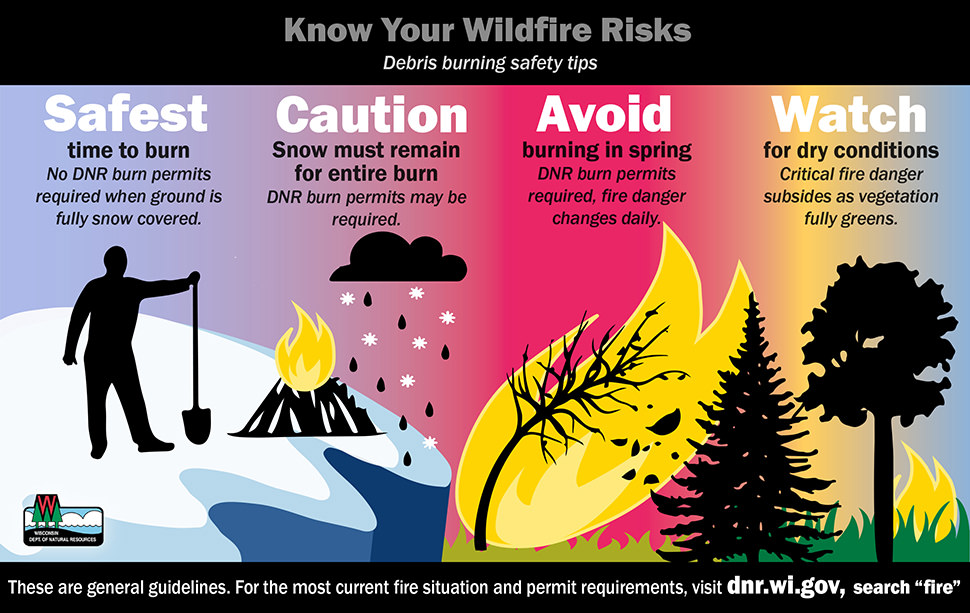
Posted 3/1/2019
WISCONSIN WILDFIRE STATISTICS FROM 2018
In 2018 there were 842 wildfires in Wisconsin DNR Protection Areas. This map shows the locations of these wildfires.
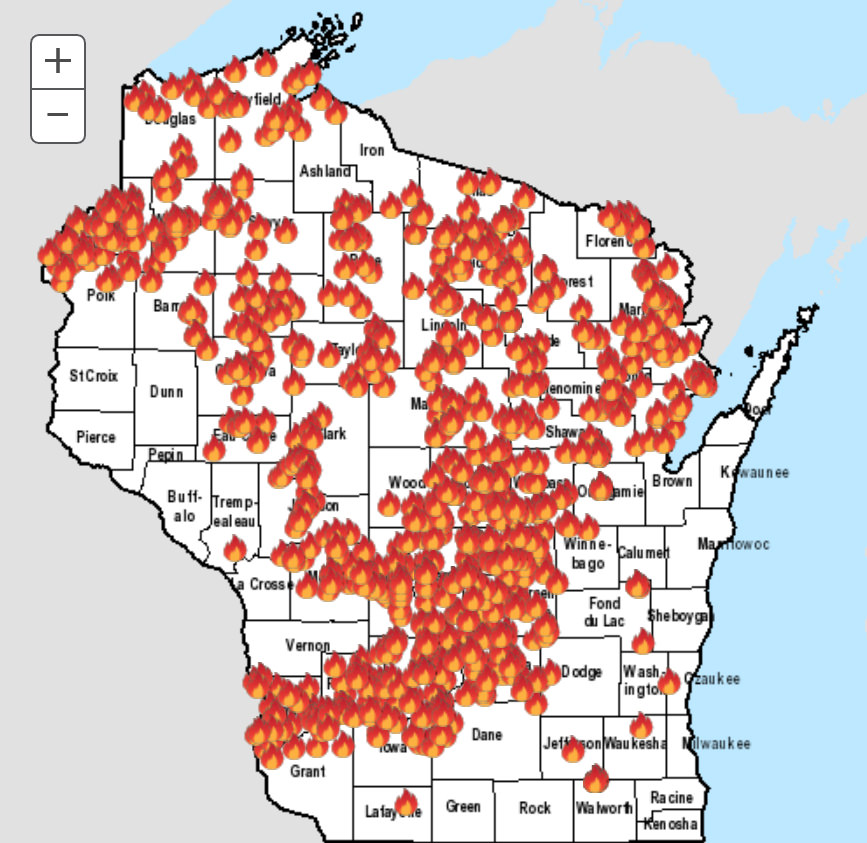
The number one cause of wildfires in WI DNR protection during 2018 was debris burning. The chart shows some of the other causes of Wisconsin wildfires in 2018
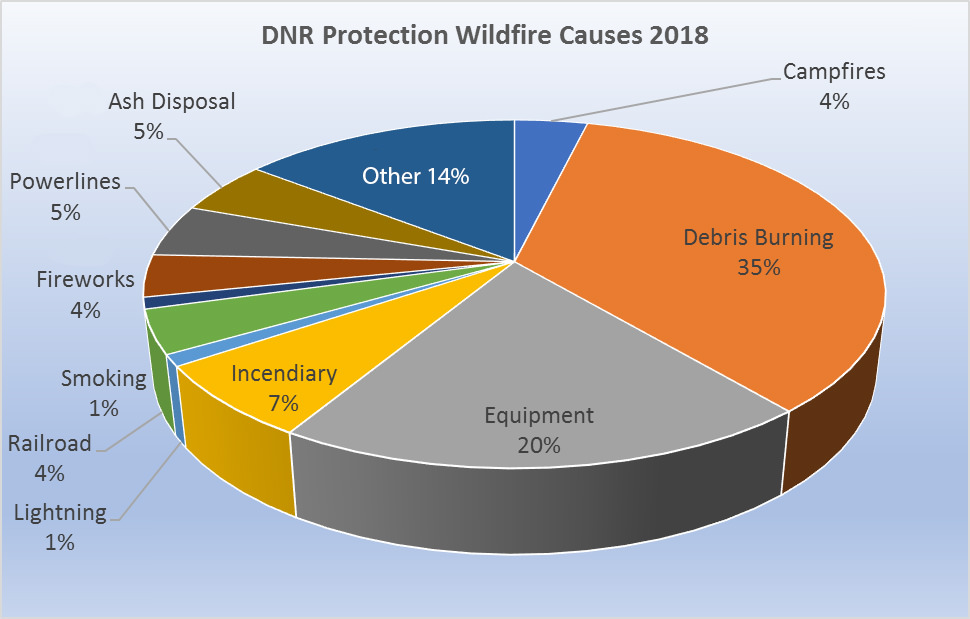
This chart shows the residency of the responsible party for all wildfires started by debris burning in Wisconsin. 74% of wildfires started by debris burning in WI DNR protection areas were started by permanent residents.
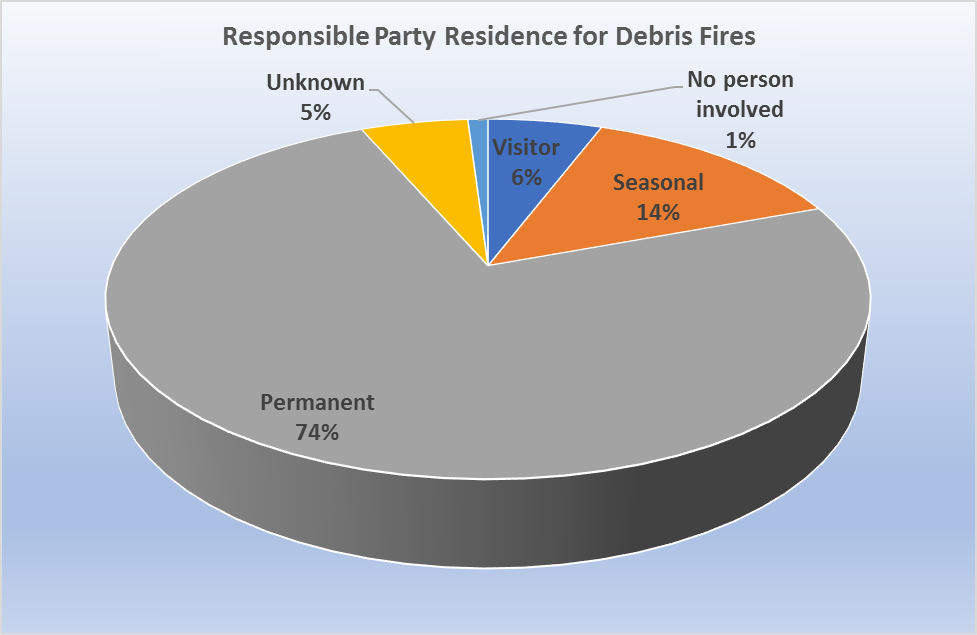
Posted 10/31/2018
IS YOUR HOME FIREWISE?
Your home was your castle in medieval times. High stone walls, massive drawbridges and deep moats protected you against competing monarchies and roving bandits.
Today, homes built in the wildland could take a tip or two from their medieval predecessors. Using non-flammable building materials and landscaping plants and providing ample access for emergency vehicles will improve the chances that your modern palace in the pines will survive a wildfire.
Many parts of a home are vulnerable to wildfire. The roof is the most exposed portion of a home exterior and is the most at risk from flying embers. Roofs near any wildland area should be constructed of noncombustible materials and all roofs and gutters should be kept clean of pine needles, leaves or other burnable material.
Unfortunately, homes are often made of materials that melt or ignite when exposed to heat or flames. Consider using fire-resistant siding and logs, masonry or stucco. Vinyl siding and soffits, when exposed to heat from a wildfire, will melt and fall away from structures, leaving a passageway for embers to ignite insulation or enter the attic. Airborne embers also can enter attics through open eaves or vents. For these reasons, it is especially important to keep flammable objects like shrubs and firewood stacks away buildings and keep eaves and vents covered with a tight mesh screen.
Anything attached to your home, such as a deck, fence or garage can also carry fire into your home. Decks should be enclosed to keep debris from collecting underneath. Keep flammable vegetation and debris away from the base of your deck, fence and garage. These are the same places where flying embers will collect should a fire occur in your neighborhood.
Windows can transmit radiant heat and break under heat stress. Tempered or double-paned glass windows will protect a home better than single-paned windows during a wildfire. Most importantly, keep flammable objects away from windows.
Clean and inspect your chimney at least once a year and use a chimney cap with a spark arrestor. Keep a garden hose that is long enough to reach any area of your home and any other structures on your property. Develop a water supply. Water can be supplied from nearby creeks, rivers, lakes, ponds and even swimming pools.
Nearly every home has some tools that can be used in the event of a wildfire. People living in fire prone areas should have some fire protection tools on hand. Shovels and rakes can be used to create a firebreak around your home. And, of course, fire extinguishers should always be on hand.
In the fire protection world, 30 feet around the home is known as "defensible space." In this space, all trees should be pruned and kept widely spaced. Evergreen trees and shrubs should be kept to a minimum. Remove dead, dying and diseased plants or plant parts. Maintain a vegetation-free zone three-feet-wide around all structures. Create "island" gardens that are separated by nonflammable features such as lawns or stones. Choose plants with fire-resistant qualities. Succulent plants, deciduous trees and shrubs, and plants with thick leaves are better suited to a fire prone environment.
Wood chips and straw are ideal places for embers to land, smolder and ignite. Use these mulches sparingly and never alongside the house.
In order for firefighters to protect your home, they must be able to reach and exit your property safely. Post the house address along the road at the driveway entrance as well as on the home.
Build and maintain your driveway so it is wide enough and straight enough for a fire engine to navigate. A good rule of thumb is a 12-foot wide driveway with 14 feet of overhead clearance. Longer driveways and those with curves should be closer to 20-feet wide.
Your castle is only as strong as its weakest point. Invest in a home sprinkler system. Take the time to assess your property and make the necessary changes. With a comfortable fleece vest as your armor and chainsaw as your sword, go forth and defend your castle.
Here are a few tips for building a fire-resistant home
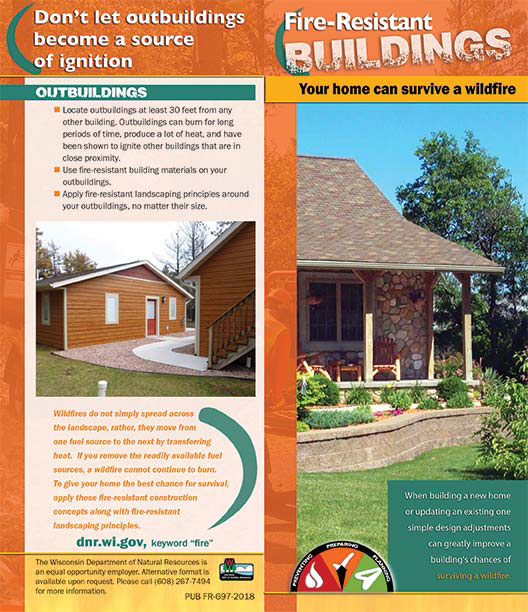
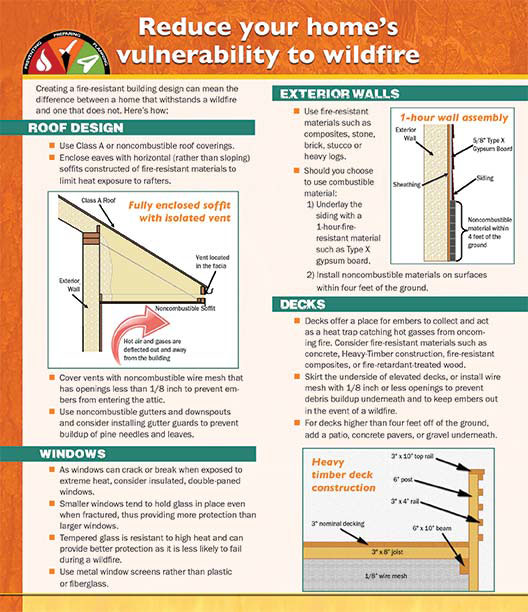
Posted 9/1/2018
FALL CLEAN-UP JUST AROUND THE CORNER
While we see most Wisconsin wildfire activity in the spring, fires can occur any time of the year when snow is not on the ground. We see spikes in occurrence in summer during dry spells and again in autumn when the leaves fall.
All this dry matter can become fuel for a wildfire. Removing this debris is particularly important if you live or own property in a community at risk for wildfire - which the Town of Washington is. In short, these are areas where sandy soils, oaks and pine trees are abundant.
What can you do? Start with the area immediately around your home and work outwards from there.
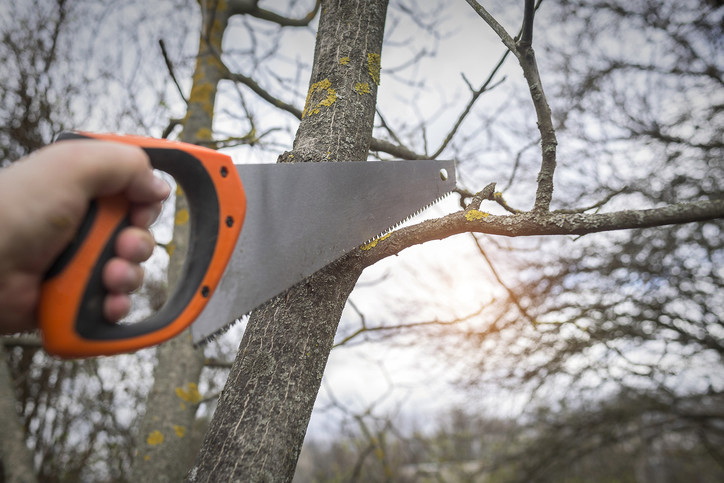
Posted 6/4/2018
TIPS FOR BURNING SAFELY
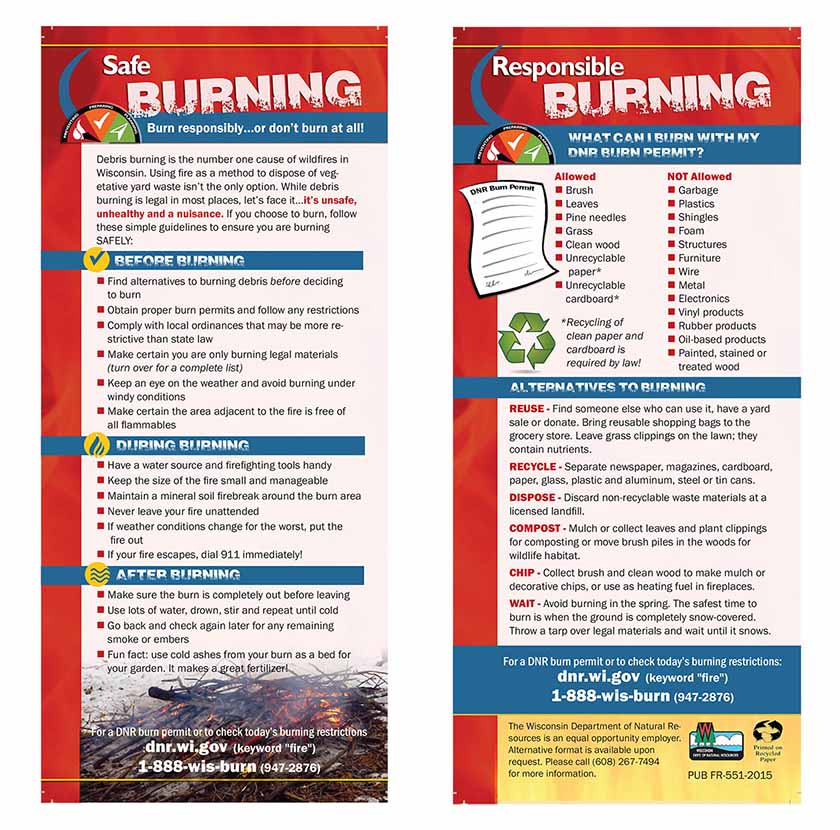
Posted 5/29/2018
HOMES CAN SURVIVE A WILDFIRE
With fire season still lingering in the north, the DNR has reported 53 structures destroyed by wildfires so far this year. The good news is, 439 were also threatened yet saved with firefighter assistance.
To find out if your home or cabin is at risk for wildfire, ask yourself these questions: Is your place surrounded by oak or pine trees? Are your rain gutters full of pine needles? Is your lawn covered with leaves? Is there a Smokey Bear fire danger sign in your community? If you answered “yes,” you might have some work to do!
As we head into summer, grab a rake and gloves, and take a peek at ways you can prepare your property for wildfire. Avoid burning by hauling the debris to our brush collection site or compost the material.
For more information on keeping your home safe from wildfire Click Here
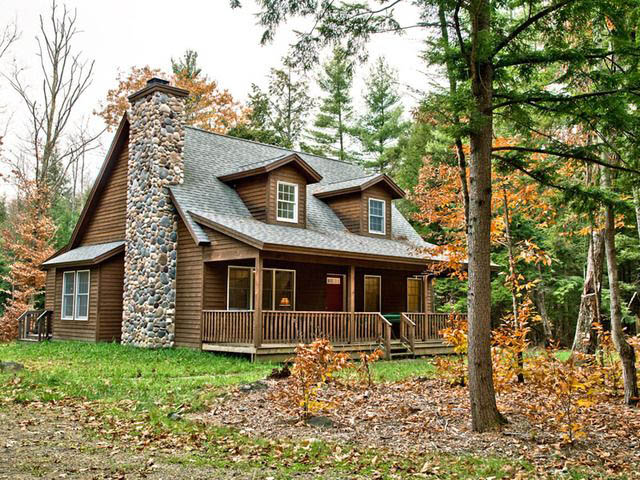
Posted 5/15/2018
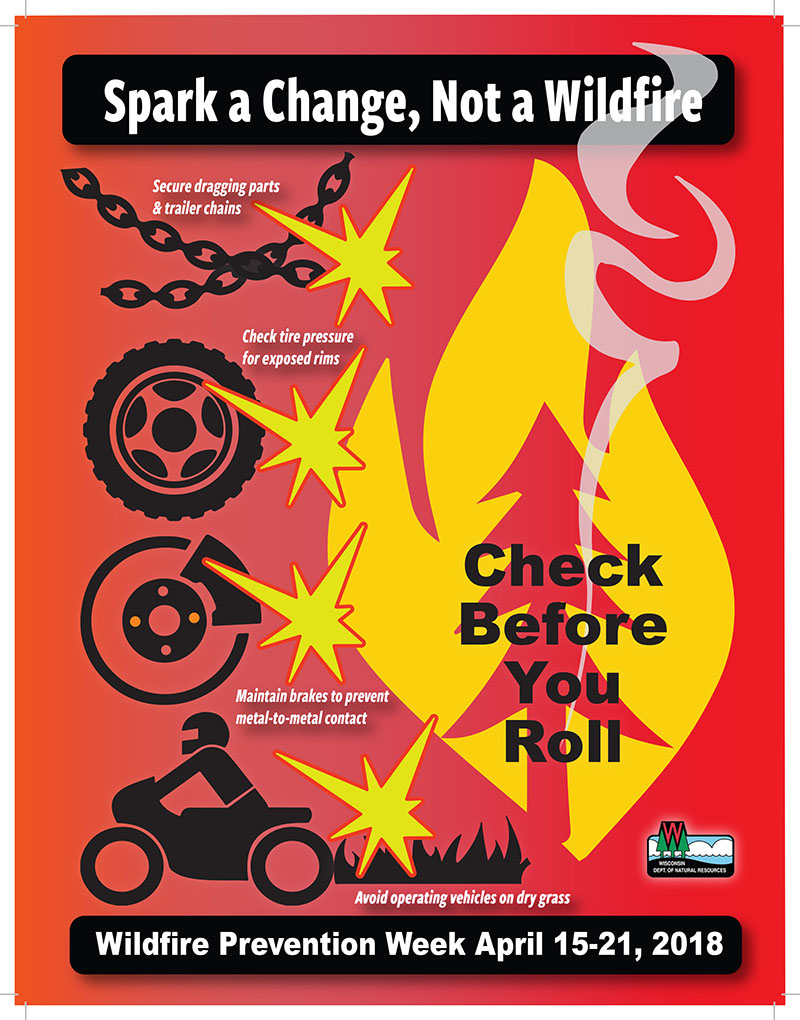
Posted 1/3/2018
OUR TOWN OF WASHINGTON PLANNING UNITS
In the development of our CWPP, the Town of Washington was divided into 4 planning units. These units were determined based upon commonalities within each unit which incluuded distribution of developed areas and structures. We use these areas to assist in risk assessment and to plan for CWPP projects. Below is a short summary of each of the areas.
The four planning units are:
- Blackjack Planning Unit
- Carpenter Lake Planning Unit
- Chain O'Lakes Planning Unit
- Cranberry Lake Planning Unit
BLACKJACK PLANNING UNIT
The specific areas of concern are Anvil Lake West and Buckrun Road.
At over 11,000 acres, the bulk of this unit is in the Nicolet National Forest. Water comprises 1,000 acres (14%) of the total acres, and the northern portion includes the Blackjack Wilderness Area. Wildfire risk ranges from moderate at the southeastern corner to very high in the northwest. Both areas abut the Blackjack.
The first area at the southern portion is along Anvil Lake and consists of hardwoods with a balsam understory surrounded by densely populated private properties with homes that are set back a distance from the road.
The second area, Buckrun Road, at the southern edge is a 1/2 mile forest road with sporadic houses surrounded by pine plantations with balsam understory.
A large tower used by cellular and internet providers is located in this area. Both areas are at high risk for wildfire.
CARPENTER LAKE PLANNING AREA
The specific areas of concern are Deerskin Road and Carpenter Lake North.
This unit is 7,500 acres and encompasses the middle third of the town north of Highway 70.
Most of this unit is privately owned. The highest number of structures are concentrated around Deerskin, Carpenter and Tambling Lakes. Total water acreage is 955 acres (13%).
There is a high risk of wildfire around most of the lakes with smaller areas at very high risk. Overhead power lines are present. Many of the residents are seasonal and the properties have very little defensible space.
CHAIN O'LAKES PLANNING UNIT
Area of concern is Eagle Waters resort.
At approximately 6,200 acres, this unit encompasses the western third of the town. Most is privately owned land and includes many large well-known and high-end resorts such as Eagle Waters, Wild Eagle and Lake Forest.
A specific concern is the one way ingress/egress on Eagle Waters Road along with the high density of structures at Eagle Waters Resort.
Water accounts for 731 acres (12%) with major water bodies being Rade, Spirit, Finger, Harmony, Scattering Rice and Voyageur Lakes. Agricultural land is located in this unit posing a risk of wildfire due to machinery ingiting fine fuels.
The fire risk in this unit ranges from moderate to high. Concerns are population density, vulnerability of homes and fire protection capabilities.
CRANBERRY LAKE PLANNING UNIT
Area of concern is Everett Road, Cranberry Lake and Bass Lake
This unit is approvimately 5,200 acres and encompasses the middle third of the town. Two highly populated areas on a narrow peninsula south of Highway 70 have a very high risk of wildfire. Ingress/egress on Everett Road along wtih a high density of structures is a specific concern. Most of this unit is privately owned land.
Major waterbodies are Catfish, Cranberry and Bass lakes. Total water within the area is 1,300 acres (25%).
Concerns in this area are population density, vulnerability of homes and fire protection capabilities.
